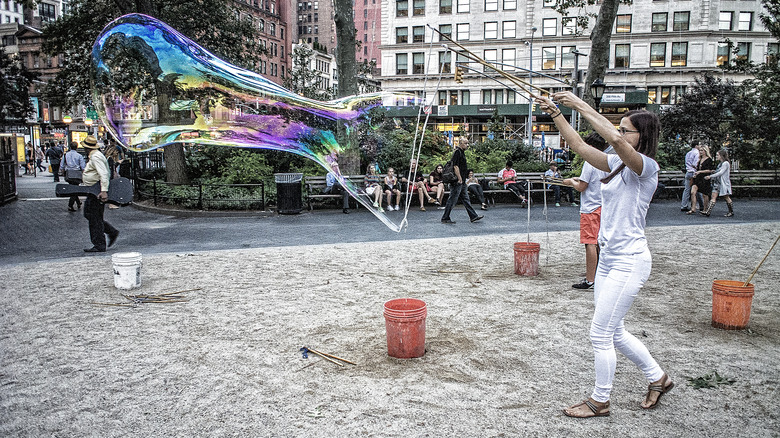The Real Reason Bubbles Pop, According To Science
There's something strangely therapeutic about the act of blowing bubbles. For generations, we've delighted in the simple act, whether it's happened inadvertently while doing the dishes or while using a bubble wand. Today, elaborate bubble-blowing machines can create dizzying amounts of them in seconds.
The trouble is, as beautiful and marvelous as they are, they last for only a fleeting moment. A bubble needs only to make contact with a surface before it vanishes, leaving only a soapy little smear behind. So inevitable is this fate that the phrase "burst someone's bubble" has come to mean something pleasurable or positive coming to a quick end. Per Merriam-Webster, the phrase is defined as "to cause someone to suddenly realize that something believed, trusted, or admired is not really true, good, etc."
What is it about bubbles, however, that makes them so prone to popping so quickly? According to the experts, it seems that several factors combine to cause this, from the inherent fragility of a bubble to the power of surface tension.
Short-lived soap bubbles
Whether a soap bubble or a soda bubble, these little wonders have that same tragically short life span in common. To explore why that is, it's important to take a closer look at exactly what a bubble is. A soap bubble, according to ThoughtCo, is composed of air, water, and molecules of soap. Their generally spherical shape is a result of the fact that this form expends the least energy.
HowStuffWorks adds that one end of these molecules remains in the water while the other moves away from it (being hydrophilic and hydrophobic, respectively). As a result, the water is trapped within the molecules, and this is the body of the bubble (which catches the light in such glorious fashion). The water's surface tension is very low as a result, which is part of what makes bubbles so pop-prone.
Per Science ABC, the integrity of a bubble, which is so thin, is easily compromised. With the loss of the surface tension comes the bursting of the bubble. This, in turn, can release the water, which is the reason why a happy game of bubble-blowing can leave a surprising amount of water behind. There's a little more to the story than just that, however.
If they're not popped, they'll pop themselves
Abhinandan Agrawal explains that the bubbles in a bowl quickly pop because the water molecules are pulled away from them (via MIT). The water surface has such a high surface tension in comparison, which is why they quickly vanish: the wafer-thin body of the bubble is quickly overwhelmed. In contrast, soap bubbles form (and maintain themselves for a longer time) because there is lower surface tension in the surrounding water. In short, if you like bubbles, you should probably do the dishes more often if you want them to last.
Even soap bubbles, however, have strictly limited time before they burst. This will happen whether a bubble is manually popped — say, by an energetic child or pet — or not. HowStuffWorks adds that untouched bubbles will pop of their own accord because they consist largely of water, which can evaporate. When this happens, the integrity of the bubble breaks up completely. This happens faster in higher temperatures, and touching a bubble will see it burst immediately as the water falls to the ground through the compromised skin of the bubble.
The bubbles in soda, meanwhile, rush to the surface and burst because the pressurized carbon dioxide returns to the air (via Live Science).


